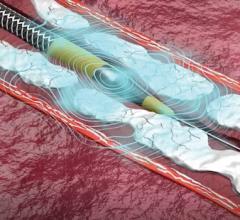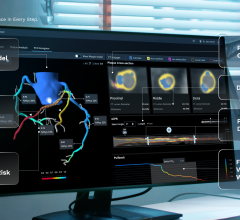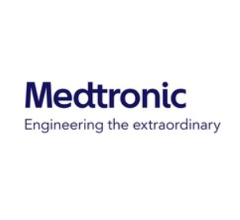
OCT comparison between the Combo vs. Xience stents in the HARMONEE study.
November 8, 2017 – New results from the HARMONEE Japan/U.S. Registration Trial, reported by in a first report investigations session at the 2017 Transcatheter Cardiovascular Therapeutics (TCT) scientific symposium, demonstrate that the OrbusNeich Combo Dual-therapy Stent (DTS) compares favorably to the market-leading Abbott Xience stent for treating patients with significant ischemic heart disease.
The Japan-United States of America Harmonized Assessment by Randomized Multicenter Study of OrbusNEich’s Combo StEnt (HARMONEE) is a pivotal (Shonin, Japan) registration study being conducted to demonstrate the effectiveness of the combined endothelial progenitor cell capture and drug-eluting stent (COMBO) compared to the Xience stent in patients with ischemic coronary disease and non-ST-elevation acute coronary syndrome. The results showed that the overall incidence of the primary endpoint target vessel failure (TVF) was lower than the original estimated 9 percent, with 7 percent in the Combo group vs. 4.2 percent in the Xience group at 12 months, thereby meeting the non-inferiority requirement (P = 0.020).[1]
“Achieving non-inferiority in TVF compared to the best-in-class current DES, with the addition of superior surrogate measures of site healing by COMBO in this randomized study, represents the opening of an exciting new chapter in percutaneous coronary intervention device design targeting enhanced safety and effectiveness for patients with coronary artery disease,” said Principal Investigator Mitchell Krucoff, M.D., Ph.D., FACC, FAHA, FSCAI, professor of medicine/cardiology, Duke University Medical Center, director, cardiovascular devices unit, Duke Clinical Research Institute, Durham, N.C.
Kaplan-Meier curves revealed that target vessel revascularization (TVR) events driven by the one-year protocol re-catheterization were notable in both stent groups, despite the use of fractional flow reserve (FFR) to mitigate such event spikes. The TVF odds ratio of Combo versus imputed bare-metal stent (BMS) was 0.673 and did not meet the pre-specified assay sensitivity, but the comparison was underpowered due to the low TVF rates (4.2 vs. predicted 9 percent). Combo was superior to imputed BMS with respect to angiographic in stent (P<0.001) and in segment late-loss (P=0.003) at 12 months.
An independent quantitative coronary arteriography core laboratory reported in stent late loss at one year of Combo vs. Xience of 0.293 mm vs. 0.219 mm and in segment late loss of 0.229 mm vs. 0.220 mm respectively. Additionally, the angiographic in stent restenosis of Combo vs. Xience was 1.3 vs. 2.6 percent and in segment restenosis was 2.5 vs. 3.9 percent.
Optical coherence tomography (OCT) at 12 months revealed significantly better healthy tissue strut coverage (thickness >40 micron in patients with normal FFR) with Combo vs. Xience (91.56 vs. 74.82 percent; P<0.001). Also, the qualitative appraisal of the neo-intima showed more homogeneous tissue with Combo vs. Xience (81.2 vs. 68.8 percent). “OCT observations suggest an active mechanistic role of EPC technology including superior healthy tissue strut coverage with Combo vs. the everolimus-eluting stent, and more qualitatively homogeneous neointimal tissue with Combo,” Krucoff explained.
The results from HARMONEE build further evidence for Combo and help to support OrbusNeich’s planned application for approval in Japan and to meet the feasibility trial requirements in the U.S.
About the HARMONEE Study
The HARMONEE study [NCT02073565] was conducted in 50 hospitals in Japan and the USA, enrolling a total of 572 patients, who were randomized to receive a COMBO stent or a Xience stent in a 1:1 fashion. The protocol defined primary clinical endpoint of the HARMONEE study was target vessel failure (TVF), a composite of cardiac mortality, myocardial infarction, or ischemic target vessel revascularization within one year of post index treatment. Fractional flow reserve (FFR) was used as an objective quantitative indicator for ischemia. OCT assessments were performed after six and 12 months in subsets of patients in order to provide mechanistic insights into the healing patterns in both groups, with attention to factors likely to be affected by the EPC capture technology. All patients were followed up at 12 months with quantitative coronary angiography (QCA), including FFR.
For more information: www.OrbusNeich.com
Related Content
TCT 2017 Late-breaking Clinical Trial Presentations
Reference:
1. Krucoff M, Saito S. “HARMONEE: A Randomized Trial of a Bioabsorbable Polymer-Based DES with a Luminal CD34+ Antibody Coating vs a Durable Polymer-Based DES in Patients with Coronary Artery Disease.” Oral presentation at the 29th annual Transcatheter Cardiovascular Therapeutics scientific symposium, Oct. 30, 2017.




 November 14, 2025
November 14, 2025 









